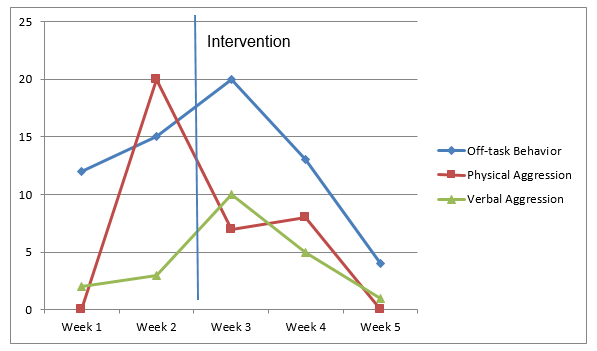Time Series Design
It is desirable that the patient should be exposed to a series of observations and assessments carried out on a weekly basis. After the implementation of the intervention, the patient must be observed carefully, with the data concerning her behavior written down and reported properly (Sheperis, Young & Daniel, 2009). It will be reasonable to suggest that Kaya’s behavior should be observed during recess at school as in the previous assessment session. Likewise, the parameters for the child’s behavior assessment will include off-task activity (i.e., the inability of the child to focus on a specific activity), the analysis of the instances of physical violence and the cases of verbal one. However, it is reasonable to suggest that the minimum amount of time for the learner to maintain focus on the task should be increased to five seconds.
It will be rather adequate to increase the time spent on the assessment of the child’s behavior I terms of her displaying or attempting at physical and verbal violence towards her peers and teachers. Specifically, the observations of the child’s responses towards the factors that have been marked as negative irritants (e.g., offensive remarks of her peers, rigid instructions from her teachers, etc.) will have to be more lengthy (e.g., 15–20 minutes). Herein the need to carry out the observations during not only recesses, but also the time that the child spends in class, lies. The graph built with the help of the cyclic patterns analysis method will look the following way:

Behavioral Intervention
As the results of the study conducted prior to the intervention have shown, there is an obvious need to incorporate the approaches, which will help the child control her behavior and establish proper relationships with her peers. Specifically, the approaches aimed at assisting the child in recognizing her emotions, accepting them as normal and learning to cope with them in a timely and efficient manner must be viewed as imperative ones at the specified stage.
First and most obvious, there is a critical need for allowing the child to increase the rate of her emotional intelligence (McKenna & Webb, 2013). Specifically, Kaya will have to learn to identify the negative emotions, which she experiences, and learn to accept them instead of dismissing them as inappropriate. Once the child learns that her emotions are nothing to be ashamed of or shunned for, she will be capable of recognizing them and, therefore, navigating her emotional experiences. As a result, the violence in her responses towards the outside irritant will most likely be reduced.
The development of emotional intelligence in the child will require that Kaya should be capable of naming the emotions that she experiences at specific moments, such as conflicting with her peers, receiving instructions from her teacher, etc. The given stage of intervention is likely to take approximately two weeks, including the consistent training of the child, i.e., the development of skills for emotional intelligence in the situations, which presuppose interaction with her peers and teachers (Borckardt, Nash, Murphy, Moore, Shaw, & O’Neil, 2008).
As soon as Kaya is capable of identifying the basic emotions, which she experiences in the course of communication with her fellow students and teachers, the need to help her determine the strategies, which will contribute to locating the compromise and can be identified as coping methods, will emerge. Specifically, Kaya will have to be provided with the alternative communication patterns and suggested the strategies for conflict solution, which do not presuppose verbal or physical aggression and, instead, focus on the peaceful resolution of the confrontation.
The next phase of the intervention will require the participation of the teacher. It is essential that each time, when Kaya follows the acceptable norms of behavior, the teacher should reward her with an appraisal. The behavioral pattern, which the teacher should adopt when addressing conflicting situations involving the student, should also demonstrate support and contribute to the reduction in the student’s anxiety rates.
To be more exact, the teacher will have to provide Kaya with the information, which will allow her to view the situation as solvable in the ethically acceptable way. In addition, the teacher will have to encourage the student for proper communication, including both verbal and physical one. In other words, the teacher will have to explain Kaya why hitting her peers or exercising any other form of physical aggression is inacceptable and must not take place in any possible scenario.
The assessment of Kaya’s progress will be conducted based on the results retrieved in the course of the current intervention strategy and the one adopted previously. It is expected that the child will display keen abilities in determining the alterations in her emotional state, as well as develop the coping mechanism, which will allow her to handle the emerging conflicts in a socially acceptable manner. Moreover, Kaya is also expected to display a better aptitude to keeping her attention focused on the subject matter for at least five consecutive seconds. The Kaya’s aggression rates will supposedly drop as soon as the child will be capable of determining the cause of her irritation and handle the emerging problems independently.
Reference List
Borckardt, J., Nash, M., Murphy, M., Moore, M., Shaw, D., & O’Neil, P. (2008). Clinical practice as natural laboratory for psychotherapy research: A guide to case-based time-series analysis. American Psychologist, 63(2), 77–95. Web.
McKenna, J. & Webb, J.-A. (2013). Emotional intelligence. The British Journal of Occupational Therapy, 76(12), p. 560. Web.
Sheperis, C. J., Young, S. J. & Daniel, M. H. (2009). Time series designs. In Counseling research: Quantitative, qualitative, and mixed methods. Upper Saddle River, NJ: Pearson. Web.